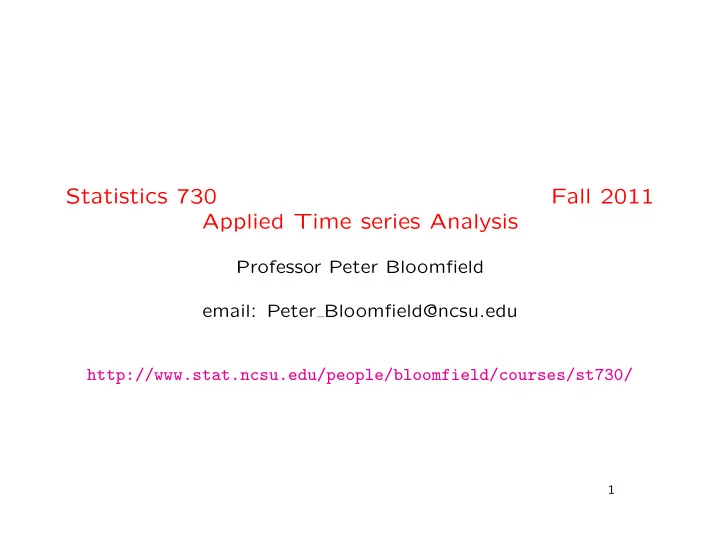

Statistics 730 Fall 2011 Applied Time series Analysis Professor Peter Bloomfield email: Peter Bloomfield@ncsu.edu http://www.stat.ncsu.edu/people/bloomfield/courses/st730/ 1
Characteristics of Time Series • A time series is a collection of observations made at different times on a given system. • For example: – Earnings per share of Johnson and Johnson stock (quar- terly); – Global temperature anomalies from 1856 – 1997 (annual); – Investment returns on the New York Stock Exchange (daily). 2
Digression: Retrieving the Data Using R jj = scan("http://www.stat.pitt.edu/stoffer/tsa2/data/jj.dat"); jj = ts(jj, frequency = 4, start = c(1960, 1)); plot(jj); globtemp = scan("http://www.stat.pitt.edu/stoffer/tsa2/data/globtemp.dat"); globtemp = ts(globtemp, start = 1856); plot(globtemp); nyse = scan("http://www.stat.pitt.edu/stoffer/tsa2/data/nyse.dat"); nyse = ts(nyse); plot(nyse); 3
Correlation • Time series data are almost always correlated with each other– autocorrelated . • We may want to exploit that correlation, or merely to cope with it. 4
Exploiting Correlation: Forecasting • Suppose Y t is the t th observation, and we observe Y 0 , Y 1 , . . . , Y n − 1 . What can we say about Y n ? • If we know the correlation structure, or more precisely the joint distribution , of Y 0 , Y 1 , . . . , Y n − 1 , Y n , then we calculate the conditional distribution of Y n | Y 0 , Y 1 , . . . , Y n − 1 . • The conditional mean is the best forecast of Y n , and the con- ditional standard deviation is the root-mean-square forecast error. If the conditional distribution is normal, we can use them to make probability statements about Y n . 5
Coping with Correlation: Regression • Suppose instead that Y t is related to a covariate x t , and we are interested in the regression of Y t on x t . • Because the Y s are correlated, we should not use Ordinary Least Squares to fit the regression. • If we knew the correlation structure, we would use General- ized Least Squares. • Usually we don’t know it, so we must estimate it, typically using a parsimonious parametric model . 6
Time Domain and Frequency Domain • Methods that focus on how a time series evolves from one time to the next are called time domain methods. • Some graphs (e.g. residuals of global temperatures from a quadratic trend) suggest the possibility of waves in the data: l = lm(globtemp ~ time(globtemp) + I(time(globtemp)^2)); plot(globtemp - fitted(l)); • Since a wave is described in terms of its period, or alterna- tively its frequency , methods that measure the waves in a time series are called frequency domain methods. 7
Recommend
More recommend